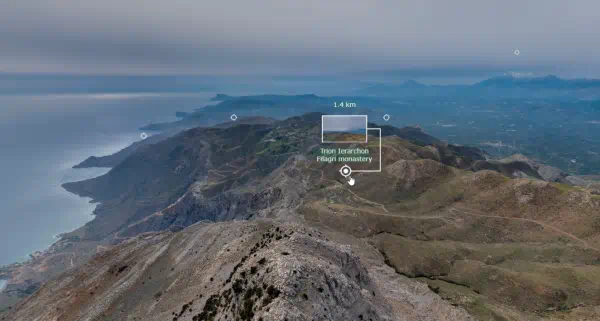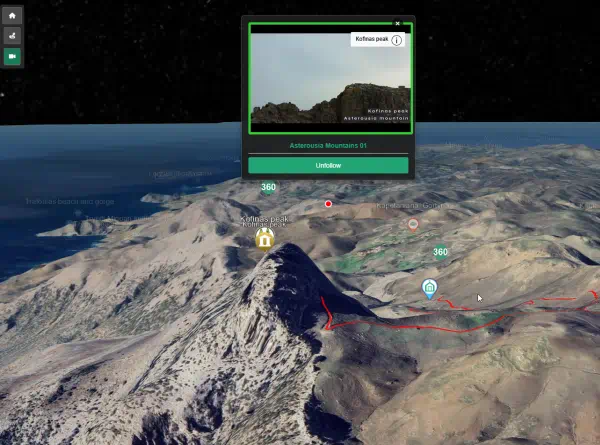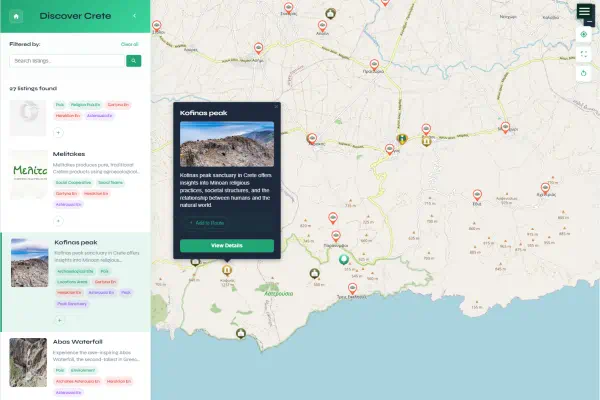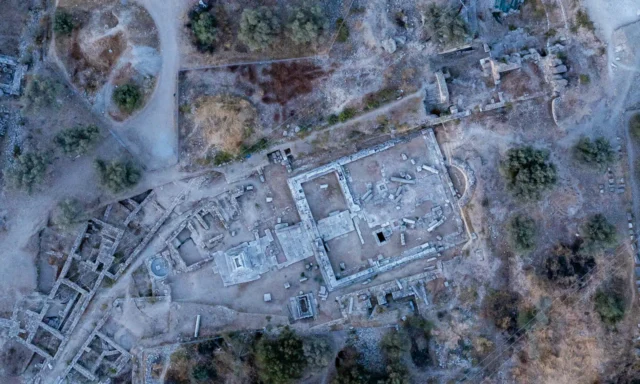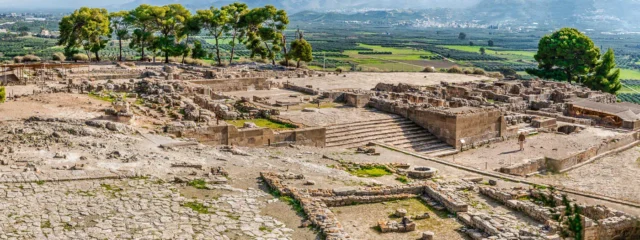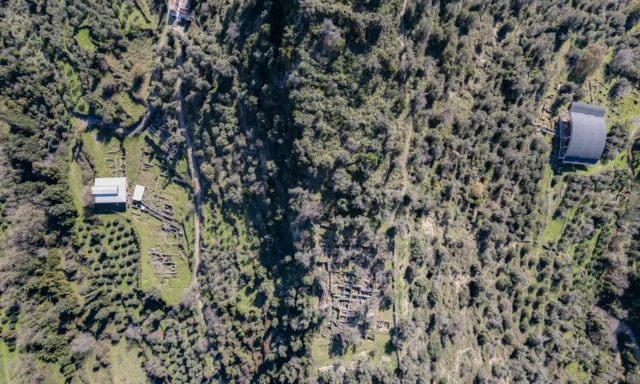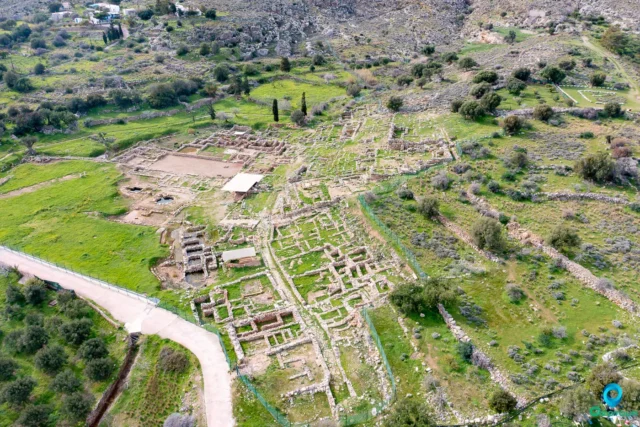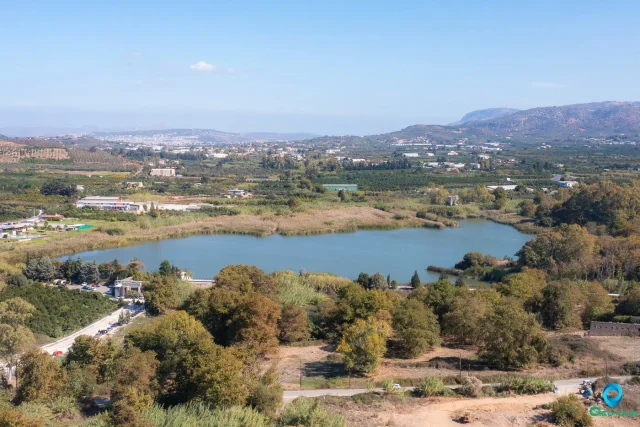Located on the northwest coast of Crete, the city of Chania shows the long history and the influence of different cultures that have shaped the Mediterranean world. Its Venetian harbor and Old Town attract many visitors, but the city also has a long history extending over thousands of years. Chania reflects the layered history of Crete. The city shows the influence of different civilizations – Minoan, Greek, Roman, Byzantine, Arab, Venetian, and Ottoman – each shaping its character.
Important to Chania’s history is the low hill known as Kastelli, located near the harbor. Archaeological evidence confirms this location has been continuously inhabited since Neolithic times, making Chania one of the world’s oldest continuously occupied sites. This continuous occupation, despite periods of conquest and destruction, highlights the site’s advantages – its defensible position, closeness to a natural harbor, and access to nearby fertile land. This continued settlement on Kastelli means that the modern city is built on the remains of earlier settlements, connecting it to its past. Over centuries, it developed from the important Minoan city-state of Kydonia into an important administrative and commercial center under different rulers. It was called the “Venice of the East” during its Venetian period and was the capital of Crete during important periods in its modern history.
This report examines the history and cultural heritage of Chania. It focuses on historical and cultural information, following the city’s development from the Bronze Age Minoan settlement of Kydonia through periods of Greek, Roman, Byzantine, Arab, Venetian, and Ottoman rule, ending with its role in modern Crete. It emphasizes archaeological discoveries, the development of its urban area – particularly the Old Town and harbor – its varied architecture, periods of foreign administration and local resistance, and the specific cultural traditions that characterize Chania and Western Crete. The institutions that preserve and show this heritage will also be discussed, providing an understanding of a city developed over thousands of years at a meeting point of cultures.
The long and complex history of Chania, influenced by changing powers and cultures, is summarized in the table below, providing a timeline for the following information.
Ancient Kydonia
Chania’s history begins in Crete’s prehistoric past. Archaeological investigations, particularly on the hill of Kastelli overlooking the natural harbor, have found evidence of human settlement dating back to the Neolithic Age, around the 4th millennium BCE. This makes modern Chania one of Europe’s oldest continuously inhabited locations. From these early beginnings, a large urban center developed during the Minoan civilization (c. 2700-1100 BCE). This settlement became known as Kydonia, a name found in Linear B script as ku-do-ni-ja. Ancient legends recorded by writers like Diodorus Siculus attributed its founding to King Minos or his grandson Kydon. Regardless of its mythical origins, ancient sources like Homer and Strabo consistently recognized Kydonia as one of the most important and powerful cities on Minoan Crete, often ranked with Knossos and Phaistos. Its location on Kastelli hill provided natural defense and overlooked the harbor and the fertile plains extending southwards, good conditions for a settlement.
Excavations, although difficult due to later historical layers and the modern city, have shown parts of an advanced Minoan urban center, particularly from the Proto-Minoan (Early Minoan) and Neo-Palatial (Middle and Late Minoan) periods. Early Minoan Kydonia (c. 3650–2200 BCE) was already an important settlement, shown by large residences with well-built rooms, floors with circular cavities (perhaps hearths), walls coated with deep red mortar, and high-quality ceramics. During the Middle Minoan period (c. 2200–1580 BCE), Kydonia developed into an active center, with an economy based on agriculture and increasingly on trade and shipping. The city was most developed during the Late Minoan period (c. 1580–1100 BCE), particularly between 1550-1450 BCE. Archaeological findings from this time suggest a well-organized city, possibly laid out in blocks or squares, with wealthy houses having complex architectural features similar to Minoan palaces. These features included multiple doorways (polythyra), light wells, carefully constructed facades, and an advanced sewage system. This prosperous period ended suddenly around 1450 BCE (Late Minoan IB) when a major fire destroyed the settlement on Kastelli, covering architectural remains.
The administrative complexity and economic reach of Minoan Kydonia are shown by important archival discoveries. Excavations have found many documents inscribed in the Minoan Linear A script, including 97 clay tablets (the second-largest find of this type in Crete), 122 roundels, and 28 nodules. These records, listing agricultural products and counts of people and animals, show an advanced administrative system supporting a centralized economy. The later discovery of Linear B tablets, dating to the Late Minoan IIIA/B period (after the 1450 BCE destruction), also shows Kydonia’s continued importance. The fact that Kydonia is one of only three sites in Crete (with Knossos and Malia) where Linear B has been found suggests it was still a major administrative center during the period of Mycenaean influence or control on the island. These archives support Kydonia’s role as an important center for trade and shipping. The city developed its own pottery style, known as the “workshop of Kydonia,” exporting its goods across the Mediterranean to places like mainland Greece (Patras), Cyprus, Sardinia, and possibly Italy and Egypt. At the same time, it imported goods from these areas, showing it was part of a large trade network. Special transport vessels, such as inscribed stirrup jars, were used for this trade, particularly for liquids like oil or wine.
The archaeological work on Kydonia began in 1966 and continues, mainly done by the 25th Ephorate of Prehistoric and Classical Antiquities, often working with the Swedish Institute at Athens. Key excavation areas include Kastelli hill, the nearby Splantzia district, and Ayia Aikaterini Square. However, finding the full extent of the Minoan city is difficult because of the continuous occupation and the layers of later Greek, Roman, Byzantine, Venetian, and Ottoman construction, as well as modern development, that cover the Bronze Age remains. Despite these difficulties, the findings, many shown in the Archaeological Museum of Chania, show a powerful, resilient, and advanced Minoan center that was important in Western Crete for centuries. The combination of palace-like architectural elements, advanced administration shown by Linear A and B archives, wide international trade connections, and its mention in ancient texts confirms Kydonia’s status not just as a Minoan city, but as an important regional center that managed the difficult changes of the Bronze Age, staying important into later historical periods. Its ability to rebuild after the major fire around 1450 BCE shows its strength and the value of its location. While the limits of urban archaeology make it hard to know if Kydonia had one large palace like Knossos, the evidence suggests a major elite and administrative center, perhaps with several important buildings, that acted as the center of a powerful Minoan state in the west.
From City-State to Roman Province
After the decline of the Minoan and Mycenaean civilizations around 1100 BCE, Kydonia entered the historical era, remaining an important city-state. The Dorian Greeks were among the first post-Minoan settlers from the mainland. An important event in its early historical period, according to Herodotus, was the arrival of colonists from Samos in 524 BCE, leaving because of the rule of Polycrates. These Samians are said to have founded or re-founded the classical city and built temples visible in the 5th century BCE. However, their stay was short; after five years, they were defeated and enslaved by forces from Aegina. The Aeginetans had helped the native Cretans and then settled in Kydonia, becoming a large part of its population.
Throughout the Classical and Hellenistic periods (c. 500 BCE – 69 BCE), Kydonia remained important in the often changing politics of Crete and the larger Aegean area. Its territory was large, extending from Cape Spatha west to Melecha east, and south to the base of the White Mountains and the territory of Aptera. The city often had conflicts and alliances with its neighbors. In 429 BCE, it was looted by nearby Polychnia, who were helped by the Athenians, even though Kydonia usually had good relations with Athens. In 343 BCE, it successfully fought off a siege by the Phokian mercenary commander Phalaikos. Alliances changed; Kydonia was allied with Knossos in the mid-3rd century BC but was forced by its western neighbor Polyrrhenia to end this alliance around 220 BCE during the Lyttian War. Kydonia’s own power grew, especially from the 4th century BCE, making it the main power in Western Crete by the 2nd century BCE. It conquered the port city of Phalasarna, although Roman action later forced Phalasarna to be restored. Kydonia also fought with Gortyn, including taking action against Gortyn for destroying the city of Apollonia around 171 BCE. For long periods, it also controlled the important sanctuary of Diktynnaion. Showing its wealth and independence, Kydonia began making its own coins as early as the 5th century BCE, which it continued even under Roman rule.
Kydonia’s independence eventually came into conflict with expanding Roman power. The city initially resisted strongly. In 71 BCE, Kydonian forces defeated an invasion led by Marcus Antonius Creticus, the father of Mark Antony. When Rome sent a larger force under Quintus Caecilius Metellus in 69 BCE, Kydonia, led by generals Lasthenes and Panaris, again played a main role in the Cretan resistance. Despite early successes, the Cretans were finally defeated, and Kydonia was conquered and looted by Metellus (who received the title “Creticus” for his campaign).
Despite the conquest, Kydonia did well under Roman rule. Its location’s importance and perhaps its earlier display of strength were recognized. In 30 BCE, after the Battle of Actium, Emperor Augustus gave Kydonia the status of a free and independent city, probably as a reward for supporting Octavian against Antony. This status allowed it to continue making its own currency. The Roman era saw much construction, including expensive private homes and public buildings. Archaeological finds from this period include detailed mosaics, such as a 3rd-century CE picture of Poseidon and Amymone found south of the modern Cathedral, remains of bath complexes with hypocausts, many tombs (often cist graves or hypogaea), and evidence of ceramic kilns. A Roman theatre, mentioned by travelers as late as the 16th century but now gone (likely destroyed by the Venetians for building materials), and an aqueduct were also used in the Roman city. Kydonia remained one of Crete’s most important cities during the Roman period and later.
The city’s actions during the Hellenistic and Roman periods show a practical approach to keeping its independence and regional influence in Western Crete. Its willingness to change alliances – sometimes joining with powerful neighbors like Knossos or outside powers like Athens and Macedon, other times opposing them – suggests its foreign policy was based on its own interests, not loyalty. The strong initial resistance against Rome, followed by the strategic choice to support Octavian, was successful in the end, getting Kydonia a special position within the Roman province. This ability for political moves, combined with its natural location and economic advantages, helped Kydonia manage centuries of conflict and keep its status as a main city of Crete.
Byzantine Resilience and Arab Interruption
Located on the northwest coast of Crete, the city of Chania shows the long history and the influence of different cultures that have shaped the Mediterranean world. Its Venetian harbor and Old Town attract many visitors, but the city also has a long history extending over thousands of years. Chania reflects the layered history of Crete. The city shows the influence of different civilizations – Minoan, Greek, Roman, Byzantine, Arab, Venetian, and Ottoman – each shaping its character.
Important to Chania’s history is the low hill known as Kastelli, located near the harbor. Archaeological evidence confirms this location has been continuously inhabited since Neolithic times, making Chania one of the world’s oldest continuously occupied sites. This continuous occupation, despite periods of conquest and destruction, highlights the site’s advantages – its defensible position, closeness to a natural harbor, and access to nearby fertile land. This continued settlement on Kastelli means that the modern city is built on the remains of earlier settlements, connecting it to its past. Over centuries, it developed from the important Minoan city-state of Kydonia into an important administrative and commercial center under different rulers. It was called the “Venice of the East” during its Venetian period and was the capital of Crete during important periods in its modern history.
This report examines the history and cultural heritage of Chania. It focuses on historical and cultural information, following the city’s development from the Bronze Age Minoan settlement of Kydonia through periods of Greek, Roman, Byzantine, Arab, Venetian, and Ottoman rule, ending with its role in modern Crete. It emphasizes archaeological discoveries, the development of its urban area – particularly the Old Town and harbor – its varied architecture, periods of foreign administration and local resistance, and the specific cultural traditions that characterize Chania and Western Crete. The institutions that preserve and show this heritage will also be discussed, providing an understanding of a city developed over thousands of years at a meeting point of cultures.
The long and complex history of Chania, influenced by changing powers and cultures, is summarized in the table below, providing a timeline for the following information.
The Ottoman Centuries
Following the Fourth Crusade in 1204 CE and the subsequent dissolution of the Byzantine Empire, Crete’s situation changed significantly. The island was given to Boniface, Marquess of Montferrat, a crusade leader. Unable to control it effectively, he sold his claim to the Republic of Venice for 1,000 silver marks and agreements for future revenue and support. Venice, a maritime power with existing trade interests in Crete, considered the island (which they named the Kingdom of Candia, Regno di Candia) important for controlling eastern Mediterranean trade routes. However, Venice did not gain control immediately. Venice’s rivals, the Genoese, led by Enrico Pescatore, Count of Malta, and with local help, took control of much of the island between 1206 CE and 1212 CE. After several years of conflict, Venice established its authority, confirmed by a treaty with Genoa in 1217 CE. Even then, Venetian control faced challenges; the Genoese, again with local Cretan support, briefly captured Chania between 1263 CE (or 1266 CE) and 1285 CE before Venice regained control. After Venetian rule was established, Chania, renamed La Canea, became the administrative center for western Crete and the location of the regional Rector (Administrator General).
During Venice’s rule (roughly 1212/1252 CE to 1645 CE), Chania changed significantly. It was sometimes called the ‘Venice of the East’. The Venetians rebuilt the city, mostly over the ruins of Byzantine Chania and ancient Kydonia, using their architectural styles and urban planning. The Kastelli hill was the central area, called ‘Castello Vecchio’. It contained the Rector’s palace and homes for Venetian nobles. A new street layout was developed within the repaired Byzantine walls. The main street, il Corso (now Kanevaro Street), had public buildings and large houses, and streets ran perpendicularly towards the harbor. Many houses were built with Venetian features, such as external staircases, courtyards, and wells. The city grew outside the old Byzantine walls, and important Catholic monasteries were built in the early 14th century CE. These included St. Francis of the Franciscans and St. Nicholas of the Dominicans.
Venice significantly changed Chania’s layout in the 16th century CE, due to the increasing threat from the Ottoman Empire. During this time, the city’s main features were built: the Venetian Harbor and the large surrounding fortifications. Harbor construction started around 1320 CE. It was meant for trade and as a naval base against pirates. Its development was slow due to problems like silt build-up in the eastern basin and wind exposure, needing regular dredging and repairs. Important harbor structures were the long breakwater at the entrance, the sea wall, the Lighthouse built at the breakwater’s end in the late 16th century CE (c. 1595-1601 CE), and the Venetian Shipyards (Neoria or Arsenali) built along the eastern basin between 1467 CE and 1607 CE for constructing and repairing ships.
At the same time as the harbor work, Venice started a large project to rebuild the city’s fortifications. Beginning in 1538 CE and lasting about twenty years, new walls were built based on advanced designs by the military architect Michele Sanmicheli. These strong defenses covered a perimeter of over 3 kilometers. They had thick, angled ramparts (over 20m high) to deflect cannon fire, a wide, deep dry moat (60m wide, 15m deep), and strong bastions at key locations: San Salvatore (NW), Schiavo/San Dimitrio (SW), Santa Lucia (SE), Sabionera (NE), the Piatta Forma platform on the south side, and the Agios Nikolaos bastion protecting the harbor jetty. The Firkas Fortress (1620 CE) was built later to protect the harbor entrance. Three main gates controlled access: Porta Retimiotta (south), Porta Sabbionara (east), and Porta San Salvatore (west). None exist today. This large construction project used local resources and forced labor and was a major Venetian investment to protect their Cretan territory from the Ottomans. The size and design of these fortifications were practical symbols of Venetian power and influenced Chania’s character.
Society in Venetian Chania was complex. Initially, Venetian rule was strict and focused on obtaining resources like sugar, wheat, wine, timber, and cheese, sometimes using forced labor. Relations between the Venetian Catholic rulers and the local Greek Orthodox people were often difficult, leading to many Cretan revolts. Although Venice tried to convert them, most Cretans remained Orthodox. Over time, relations improved, and Cretan and Venetian cultures mixed. In the late 16th century CE, facing the Ottoman threat, Venice gave more rights to the Orthodox population to gain their support. This included permission to build large monasteries like Agia Triada Jagarolon, Gouverneto, and Chrisopigi. The city’s population was about 8,200 by 1583 CE.
This period of cultural exchange increased with the arrival of Byzantine scholars and artists after the Fall of Constantinople in 1453 CE. This led to the cultural development known as the Cretan Renaissance. This combined the island’s Byzantine traditions with Renaissance Italian culture. In painting, the Cretan School developed, including artists like Georgios Klontzas, Michael Damaskenos, and Domenikos Theotokopoulos (El Greco). These painters combined traditional Byzantine methods (maniera greca) with the styles of Venetian painters like Bellini and Titian (maniera latina), adjusting their style for different works. Literature also developed, with writers using the local Cretan dialect for works in genres from Italy. Examples include the tragedy Erophile by Georgios Chortatsis, the pastoral drama Panoria by Chortatsis, and the epic romance Erotokritos by Vitsentzos Kornaros. Academies established by local scholars and nobles supported this intellectual and artistic activity. This cultural mix, resulting from long interaction and Chania’s role as a diverse center, influenced the arts and literature of Crete and the broader Greek world.
Chania in Modern Times
The end of the 19th century CE marked an important period for Chania and Crete. After the final revolts against Ottoman rule and intervention by the Great Powers (Britain, France, Russia, Italy, Austria-Hungary, Germany), the autonomous Cretan State (Kritiki Politeia) was established in December 1898 CE. Chania became the capital of this new semi-independent state. It was officially under Ottoman control but actually under international protection. The Powers appointed Prince George of Greece and Denmark, second son of the Greek King George I, as High Commissioner. He arrived near Chania to take up his position. This was an important change, moving Crete from being an Ottoman province towards independence and the goal of Enosis (union) with Greece.
The Cretan State period (1898-1913 CE) brought changes to Chania. As the capital, it became an important center for administration, trade, and culture. The first government was formed in April 1899 CE. Eleftherios Venizelos, a lawyer from Chania trained in Athens, was appointed Minister of Justice. However, major disagreements occurred between the authoritarian Prince George and the liberal Venizelos. Their conflict was about the Prince’s management of internal matters and the strategy for achieving Enosis. Venizelos supported stronger actions towards union and opposed the Prince’s methods, leading to his resignation (or dismissal) in 1901 CE.
This political conflict led to the Therisos Revolt of March 1905 CE. Venizelos and his supporters met in Theriso, a village near Chania. They formed a “Revolutionary Assembly” and announced Crete’s political union with Greece. The revolt received broad support on the island, causing clashes between rebels and the Cretan Gendarmerie, who were supported by international forces (especially Russian troops). The Great Powers declared martial law but eventually arranged a compromise. The revolt ended in November 1905 CE. Prince George had to resign. Alexandros Zaimis, a former Greek Prime Minister, replaced him, and a new, more democratic constitution was created. The Therisos Revolt, near Chania, strengthened Venizelos’s role as the main Cretan leader and helped advance the goal of Enosis.
During the Cretan State era, Chania underwent modernization and urban development, showing its status as capital and its goal of joining Greece. The city started to grow beyond the Venetian walls. New roads were built, and parts of the old fortifications, particularly on the south side, were removed to link the old and new parts of the city. The Piatta Forma bastion and nearby moat were removed between 1911 CE and 1913 CE to build the large Municipal Market (Dimotiki Agora). Neoclassical architecture became popular, changing the look of the growing city, particularly the Halepa area, where large houses, the High Commissioner’s Palace, Venizelos’s house, and foreign consulates were built. New organizations were created, such as the Bank of Crete, the Cretan Gendarmerie, and Crete established its own currency, the Cretan drachma. Intellectual and artistic groups developed, adding to a more international environment. Chania was the administrative center and a place where the political and cultural identity of autonomous Crete developed, changing physically in preparation for union.
The final move towards Enosis happened after the Balkan Wars (1912-1913 CE). Using the Ottoman Empire’s weakness and the changing political situation, Crete’s union with Greece was officially recognized. The official ceremony was held in Chania on December 1, 1913 CE, at the Firkas Fortress near the harbor. King Constantine I of Greece and Prime Minister Eleftherios Venizelos attended as the Greek flag was raised, representing the end of long struggles and achieving the Cretan goal of union.
Less than thirty years later, Chania and Crete were involved in World War II. In May 1941 CE, Nazi Germany began Operation Mercury, a large airborne invasion of Crete, the first in history. The first landings on May 20th CE targeted important airfields, including Maleme, west of Chania, and areas near Chania, Rethymno, and Heraklion. The German Fallschirmjäger (paratroopers) met strong resistance from Allied forces (British, Australian, New Zealand, and Greek troops) and the local Cretan people. Near Maleme and Chania, the Germans had very high casualties on the first day; some units were destroyed upon landing. Civilians, often using basic weapons like kitchen knives, farm tools, or old rifles, fought bravely, attacking paratroopers as they descended or landed.
Despite early problems and high losses, the situation changed at Maleme airfield. Because of communication problems, wrong intelligence, and hesitation by the Allied command, New Zealand defenders left the important Hill 107 near the airfield during the night of May 20-21 CE. The Germans quickly used this opportunity and captured the airfield on May 21st CE. This let them bring in necessary reinforcements and equipment, changing the battle’s outcome. Although heavy fighting continued, the Allied position could not be held. Chania was bombed by the Germans during the battle. By May 27th CE, the Allied commander, General Freyberg, ordered an evacuation from the south coast. The following German occupation was harsh, with mass executions and actions against civilians as punishment for their resistance. The remaining Jewish community in the city was gathered by the Nazis in 1944 CE and died when their transport ship, the Tanais, was sunk by a British submarine. The Battle of Crete was a tactical German victory, but the high paratrooper casualties caused Hitler to stop using large airborne operations later in the war. For Chania, the battle and occupation were difficult parts of its history, showing the resilience of its people.
Architectural Heritage
The city of Chania has a distinct architectural character, showing influences from different historical periods. Walking through its streets, particularly in the Old Town and harbor area, shows these historical layers. Evidence of its Minoan past (ancient Kydonia) is found underground through ongoing excavations on Kastelli hill. Parts of the Byzantine walls, built and rebuilt using materials from earlier times, still exist, showing the boundary of the ancient acropolis. The Venetian era (1252-1645 CE) had a major architectural impact, including the harbor, large fortifications, houses, and narrow streets. The following Ottoman period (1645-1898 CE) added features like converted churches (now mosques), new mosques with minarets, public baths (hamams), and fountains. The period of the autonomous Cretan State and early years after union with Greece (late 19th-early 20th century CE) involved city expansion and the construction of large Neoclassical buildings, especially in the Halepa district. This mix of architectural styles creates a distinct urban setting where history is visible throughout the city.
Chania’s architecture is a record of the city’s political and cultural changes. The large Venetian fortifications, designed by the military architect Sanmicheli, demonstrated Venetian power and their effort to protect their Cretan territory from the Ottomans. Similarly, the Ottomans showed their control by converting the main Catholic cathedral into the Hünkar Mosque and building the prominent Yali Tzamisi on the harbor. These actions showed the change in religious and political control. Later, the use of Neoclassicism during the Cretan State period for government buildings, consulates, and houses in Halepa indicated a move towards European styles, modernization, and the goal of joining Greece. The construction of the large Municipal Market, based on European designs and opened at the time of the official Union with Greece, also represented this integration and development. The city’s buildings are historical records showing the ideas and goals of their builders.
Architectural Landmarks of Chania by Era
Landmark |
Dominant Era |
Location |
Significance/Key Features |
Kastelli Hill Excavations |
Minoan |
Old Town |
Site of ancient Kydonia; Minoan houses, Linear A/B archives |
Byzantine Wall |
Byzantine |
Around Kastelli |
7th C defensive wall, reinforced post-961 AD; spolia use |
Venetian Harbor & Mole |
Venetian |
Old Town |
Major construction (1320-1600s); breakwater, commercial/naval hub |
Venetian Lighthouse |
Venetian/Egypt |
Harbor entrance |
Late 16th C base, 1830s Egyptian rebuild (minaret style) |
Firkas Fortress |
Venetian |
Harbor entrance (West) |
Built 1620; guarded harbor, barracks, prison; site of 1913 Union ceremony |
Venetian Shipyards (Neoria) |
Venetian |
Harbor (East) |
15th-17th C vaulted structures for galley repair/construction |
San Salvatore Bastion |
Venetian |
Old Town (NW) |
Part of Sanmicheli’s 16th C fortifications; houses Byzantine Collection |
Sabionera (Sand Gate) Bastion |
Venetian |
Old Town (NE) |
Easternmost harbor bastion of 16th C walls |
Schiavo Bastion |
Venetian |
Old Town (SW) |
Southwest bastion of 16th C walls |
Venetian Loggia (Lost) |
Venetian |
Kastelli |
Important public meeting place, later a mosque, demolished 1930s |
Church of St. Nicholas (Hünkar Camısı) |
Venetian/Ottoman |
Splantzia Square |
Dominican monastery church (1320), converted to main Ottoman mosque, minaret survives, now Orthodox church |
Küçük Hasan Pasha Mosque (Yali Tzamisi) |
Ottoman |
Harbor (East) |
Mosque of the Janissaries (1645); iconic harbor landmark, now exhibition space |
Etz Hayyim Synagogue |
Venetian/Jewish |
Ovraiki (Jewish Quarter) |
Venetian church converted to synagogue (16th C?), restored; only remaining synagogue |
Turkish Hamams |
Ottoman |
Various (Old Town) |
Public baths; remnants survive (e.g., Katre St, Zambeliou St) |
Splantzia Square (Plateia 1821) |
Venetian/Ottoman |
Old Town (East) |
Former Turkish quarter center; site of Hünkar Mosque, plane tree (executions) |
Topanas District |
Venetian/Ottoman |
Old Town (West) |
Former Christian/Venetian nobles’ quarter; preserved mansions |
Halepa District |
Cretan State |
East of Old Town |
Neoclassical mansions, former consulates, Venizelos’s house, Prince George’s palace |
Municipal Market (Dimotiki Agora) |
Cretan State |
Border Old/New Town |
Built 1911-13 on leveled bastion; cross-shaped plan based on Marseille market |
Archaeological Museum of Chania (New) |
Modern |
Halepa |
Houses vast collection from Minoan to Roman times in modern facility |
Maritime Museum of Crete |
Modern |
Firkas Fortress |
Exhibits on Cretan naval history, Battle of Crete |
Culture, Traditions, and Institutions
Chania’s culture reflects its history, combining Cretan traditions with influences from various rulers. The Venetian period led to the Cretan Renaissance, a development in arts and literature that mixed Byzantine and Italian styles. This influence can be seen in the Old Town’s architecture and in religious art. The Ottoman era brought new customs, foods, and architectural styles, especially in the Splantzia district. A main element of the culture is the Cretan identity, known for valuing freedom (lefteria), family and community connections, and traditions of music, dance, and hospitality (philoxenia). This identity developed over centuries of resistance against foreign rulers, from the Venetians to the Ottomans and the Germans in WWII.
Traditional Cretan music is an important part of Chania’s culture. The main instruments are the Cretan lyra (a pear-shaped, three-stringed bowed instrument), the laouto (a long-necked lute), and sometimes the askomandoura (a type of bagpipe) or the boulgari (a smaller lute). The music often accompanies traditional dances such as the Pentozali (symbolizing revolution attempts), Siganos, Sousta, and Chaniotikos Syrto. These musical and dance traditions are often performed at festivals (panigyria), weddings, baptisms, and local events, expressing community identity and history.
Cretan cuisine in Chania uses ingredients typical of the Mediterranean diet: olive oil, fresh vegetables, wild greens (horta), legumes, local cheeses (like graviera and myzithra), honey, and moderate amounts of fish and meat (especially lamb and goat). Common dishes include kalitsounia (small cheese or herb pies), dakos (rusk with tomato, cheese, and olive oil), chochlioi boubouristi (fried snails), gamopilafo (rice pilaf for weddings), lamb cooked antikristo (facing fire), and Sfakiani pita (thin cheese pie with honey). Local wine production has a long history, and the spirit tsikoudia or raki is common, often offered as hospitality. These food traditions are important to social life and culture in Chania.
Several institutions help preserve and promote Chania’s history and culture:
- Archaeological Museum of Chania: Located in a modern building in the Halepa district (opened 2022), it contains a large collection of artifacts from the Neolithic and Minoan periods (including items from Kastelli/Kydonia like Linear A/B tablets) to the Greek, Roman, and early Byzantine eras. It displays items related to the city’s ancient history.
- Maritime Museum of Crete (Nautical Museum): Located in the Firkas Fortress at the harbor entrance, this museum presents Crete’s naval history from ancient times to the present. It has exhibits on Venetian shipbuilding, the Ottoman period, the Balkan Wars, and a section on the Battle of Crete (1941 CE). An annex in the Moro Shipyard displays a reconstructed Minoan ship, the Minoa.
- Byzantine and Post-Byzantine Collection: Housed in the Church of San Salvatore, built into the Venetian bastion of the same name, this museum displays items from the early Christian, Byzantine, Venetian, and Ottoman periods, including mosaics, frescoes, icons (including works from the Cretan School of painting), architectural sculptures, ceramics, and coins, showing the region’s medieval and early modern history.
- Municipal Art Gallery of Chania: Displays collections of modern Greek art, including Cretan artists, and holds temporary exhibitions.
- Historical Archive of Crete: Located in Chania, this archive preserves documents related to Crete’s history from the Venetian period onward, including Ottoman records, Cretan State documents, and records about the island’s unification with Greece and modern history.
- Center for Mediterranean Architecture (CAM): Located in the Grand Arsenal (Megalo Arsenali) building in the Venetian harbor, CAM organizes exhibitions, lectures, and workshops on architecture, urbanism, and related arts, often connecting Chania’s heritage to wider topics.
- Eleftherios K. Venizelos National Research Foundation: Located in Halepa, near Venizelos’s former residence, this institution researches the life of Eleftherios Venizelos and the modern history of Greece and Crete.
- Folklore Collections: Several smaller collections preserve Cretan folk art, traditional costumes, tools, and crafts, sometimes housed in older buildings in the Old Town.
These institutions, along with cultural festivals, craft workshops (e.g., knife-making, ceramics, weaving), and the practices of music, dance, and cuisine, help maintain Chania’s cultural heritage.
Current Status
Currently, Chania is the second largest city in Crete after Heraklion, and the capital of the Chania regional unit. It functions as both a tourist destination and an administrative, commercial, and cultural center for Western Crete. The city’s economy depends significantly on tourism, related to the Venetian Old Town and harbor, its history, nearby beaches, and the surrounding landscape, including the Samaria Gorge. Agriculture, particularly olive oil and citrus fruit production, is also an economic contributor. Chania is a transportation hub with an international airport (CHQ) on the Akrotiri peninsula and the port of Souda, which handles ferries and naval traffic (including a NATO base). The Technical University of Crete, also on Akrotiri, contributes to the city’s academic life.
Preserving Chania’s historical character, particularly the Old Town, is a priority. The Old Town is designated as historically preserved and has undergone restoration. Many Venetian and Ottoman buildings have been converted into hotels, restaurants, cafes, and shops, aiming to maintain their architectural structure. Organizations like the Archaeological Service and the Center for Mediterranean Architecture oversee these efforts and promote awareness of the city’s heritage. Challenges include balancing tourism development with preservation needs and maintaining the Old Town as a residential area, not only a tourist site. Sustainable tourism and managing visitor numbers, particularly during peak season, are ongoing issues.
Chania is a city shaped by its history, where different cultures have interacted over time. Its history includes the Minoan city-state of Kydonia, periods of Greek, Roman, Byzantine, Arab, Venetian, and Ottoman rule, and involvement in the formation of modern Crete and its union with Greece. Its architecture includes Minoan excavations, Byzantine walls, the Venetian harbor and fortifications, Ottoman-era mosques and baths, and Neoclassical buildings from its later expansion, showing these different periods. The city’s contemporary culture, including traditions of music, dance, cuisine, and Cretan identity, connects to its past. Chania shows the influence of different cultures in Crete. The city has been continuously inhabited for over five thousand years.

